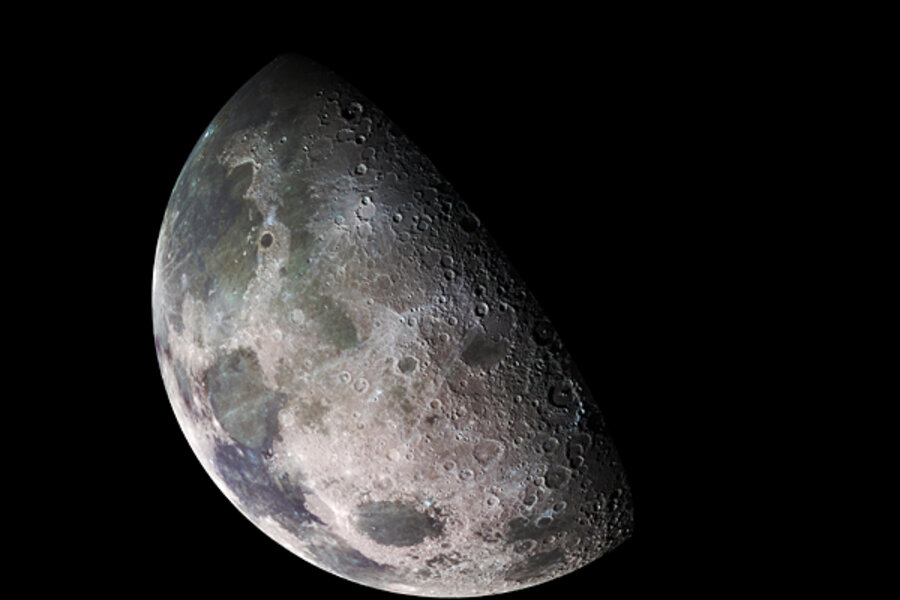Water on the moon? Maybe a lot more than we thought ... thanks to the sun.
Loading...
The moon's top layer of crushed rock and soil may hold far more water than previously estimated, according to a new study.
Most of that water can trace its origin to protons streaming from the sun, the researchers show, confirming in samples of lunar soil a mechanism for making lunar water that until now largely had been the province of theoretical models.
The find "represents an unanticipated, abundant reservoir" of water on the moon, according to researchers from three US universities, who formally reported their results Sunday in the journal Nature Geoscience. And it could help explain the presence of water on other airless planets and asteroids in the inner solar system.
"Reservoir" does not mean a source of readily tapped liquid, the researchers caution. The evidence shows up as hydroxyl – a single oxygen and hydrogen atom representing two-thirds of a standard water molecule. Hydroxyl and water molecules are captured in tiny deposits of glass in rock and soil grains. The glass forms from heat generated when micrometeoroids slam into the surface and fuse soil grains into tiny clumps.
Still, the mini-clumps containing the glass may represent between 50 and 70 percent of the material making up lunar soils, says Lawrence Taylor, a University of Tennessee geochemist who advised Apollo astronauts gathering lunar samples and has been studying those samples ever since.
"That means you've got a lot of water stuck around in this glass that we never even thought too much about before," says Dr. Taylor, who was a member of the research team.
The notion that the moon has water or hydroxyls dates back at least to the early 1960s, when researchers at the California Institute of Technology proposed that water ice might exist in the perpetually dark – and frigid – depths of craters at the moon's poles. These were suggested as the final resting places for water ice deposited by collisions between the moon and comets.
Water's presence on the moon is of more than academic interest. Split into oxygen and hydrogen, water represents a source of raw material for rocket fuel. Finding water on the moon in a form that would be relatively easy to exploit would open the possibility of using the moon as a destination as well as a staging area for human exploration beyond low-Earth orbit and living off the “land” while doing it.
Over the past decade in particular, several lines of evidence have demonstrated that the presence of water molecules and hydroxyls on the moon "is more abundant than we thought," says Paul Spudis, a geologist with the Lunar and Planetary Institute in Houston. The most-high-profile evidence came from India's Chandrayaan 1 orbiter, launched in the fall of 2008, and NASA's Lunar Reconnaissance Orbiter-LCROSS mission in 2009.
For instance, for LCROSS, the National Aeronautics and Space Administration sent the upper stage of the rocket that launched the mission crashing into Cabeus crater at the moon's south pole. Water was detected in the plume of debris that the collision kicked up, as was ammonia and methane.
But finding water in such sunless "cold traps" said little about where the water came from, let alone the hydrogen signatures showing up elsewhere on the surface.
Some of the water could have come as ice from comets colliding with the moon. A second source: in effect, the sun, whose endless stream of "solar wind" protons strike the moon's sunlit hemisphere. Bind a pair of those protons to an oxygen atom, readily available in the minerals that make up the lunar soil, and you get a water molecule. Finally, water and hydroxyl molecules also are bound up in volcanic rock and soil that originated as water-bearing magma in the moon's interior.
This latest study builds on work published earlier this year by Taylor and colleagues, in which they bombarded samples of lunar soils with hydrogen ions (protons) and ions of a heavier form of hydrogen called deuterium, which has a proton and a neutron. When the team sent these ions streaming at the soil at energy levels similar to their counterparts in the solar wind, collisions with minerals in the soil formed hydroxyl and its deuterium counterpart.
The new study, led by Yang Liu, a postdoctoral researcher working with Taylor at the University of Tennessee, not only uncovered evidence for hydroxyls in the tiny glass spheres embedded in the fused soil clumps. The team also used the ratio of two forms of hydrogen – simple hydrogen and heavier deuterium – to identify the sun as the source of most of the hydrogen the hydroxyl molecules the glass contained.
The samples Dr. Liu's group studied came from three Apollo landing sites near the lunar equator. But given the ubiquity of the collision-fused clumps in the lunar soil, the team suggests that the ices trapped at the poles could well contain hydrogen from the solar wind as well.
That may already be the case, Mr. Spudis suggests. With the discovery of water on the moon, researchers have noted that the moon appears to have its own water cycle – one in which water vapor migrates toward the poles. Water or hydroxyl molecules formed via the solar wind would take part in that migration.
The new study, he says, represents the latest link in a chain of research over the past four or five years that shows the moon as "more rich, more complex, and more interesting than we ever thought. And there's a lot about it we still don't know."








